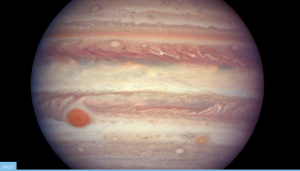
Saturn closet to Earth


Jupiter is coming to its closet point to Earth today, and the point in its orbite where its directly opposite the Sun in our sky, just 416 million miles (670 million kilometres) away and as it is the furthest, it can be upwards of 620 million miles (1 billion kilometres) away.
NASA’s Hubble telescope was able to see features on Jupiter as small as 80 miles (130 kilometres) across. The picture distinctly shows bands created by the clouds by allowing more or less light through caused by frozen ammonia, round the planet’s equator. Winds of up to 400 miles per hour (650 kilometres per hour), separate the bands. We can also spot the huge anti-cyclonic storm known as the Great Red Spot, which is shrinking and has been raging for 400 years.
Jupiter has two faint outer rings called gossamer rings and the thick inner ring is called the Halo. It also has a great red spot result of a storm which raged for hundred of years. Jupiter has 50 confirmed moons and 17 unconfirmed moons. It’s circumference is 272,945.9miles ,11 times that of Earth and weighs 100 pounds on Earth, and could weigh 253 pounds on Jupiter. And -148 °C.
It’s the biggest and worst planet in the solar system and it’s got the biggest and worst radiation and magnetic field.
From left to right, the Sun, Mercury, Venus, Earth, Mars, Jupiter, Saturn, Uranus, Neptune and Pluto. Lunar and Planetary Institute.
NASA’s Hubble telescope snapped Jupiter on April 3, 2017.
